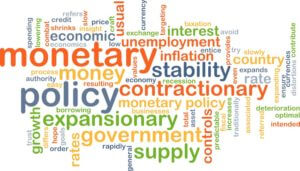
What Are Interest Rates Exactly?
Interest rates can be defined as the percentage of a principal amount that is charged by a lender. The principal amount is the money that is lent in the first place. Thus, banks pay their clients’ interest rates for deposits. This is because essentially, they are borrowing your money. Anyone that lends money can charge interest rates. However, in most circumstances, banks are the entities that implement interest rates. Banks pay interest rates to their clients to persuade people to deposit their money. Bank interest rates are typically higher for those who borrow money, as opposed to those who deposit money. This is so they can generate profit.
Moreover, banks are often in competition with one another for their rates. They compete with both borrowers and depositors. Therefore, the rivalry ensures that interest rates from most banks are within similar ranges.
Now that we have a basic idea of interest rates let us move on to risk-free interest rates. It is the rate of return on a speculative investment. Moreover, it is risk-free, because, over a given amount of time, there is no risk of facing a financial loss. Since risks free rate can be taken on with basically no risk, other investments that have risk will effectively have a higher return rate to entice investors. In order to assume a risk-free rate in a specific circumstance, risk-free bonds are used. Governments or agencies can issue risk-free bonds because their risks are insignificant.
What are Term Deposits?
Moving on, let us discuss term deposits. This is a fixed-term asset that involves the down payment into a financial institute. These investments usually have short-term maturities taking place over varying periods of time. However, it is crucial for investors to understand that buying term deposit rates means that their funds can only be withdrawn after the term terminates. Additionally, sometimes, the investor may permit early withdrawal.
Since banks can use the money deposited to lend to other businesses and consumers, early termination can become complicated. In return, the bank pays the depositor by adding interest to the balance. Thus, banks create agreements so that the money remains intangible for a fixed period. This helps banks lend money to others, without worrying about when the account holder will decide to withdraw their money.
Consumer Price Index—What Is It?
So what is a consumer price index? Well, it is a tool that studies the weighted average of prices of a basket of customer services and goods, including medical care and transport. It is computed by using price changes from each item in the prearranged group of goods and then taking their average. Changes in the CPI are applied to determine the price changes related to the cost of living. CPI is a prevalent tool. It can recognize periods of deflation or inflation.

What is Monetary Policy?
A nation’s monetary authority implements a principle known as monetary policy. They typically are in control of the interest rates, money supplies, inflation, short-term borrowing, and ensuring the validity of its currency. Moreover, the monetary policy also aims to supply stability of gross domestic products, maintain exchange rates with various currencies, and preserve low unemployment rates. In developed nations, monetary policy and fiscal policy are independent of each other. Fiscal policy focuses on government spending and taxation. Monetary policy can work in one of two ways: contractionary or expansionary.
Expansionary policy happens when monetary experts use their tools to spur the economy. An expansionary policy sustains short-term interest rates at lower rates or grows the overall economic, monetary fund rapidly. This instrument can fight recessions and unemployment. This is by reducing interest rates, assuming businesses will be motivated to expand due to lowered rates. This tactic increases the demand for services and goods in economies, promoting short-term growth. However, on the other hand, this tactic does reduce the worth of currency in comparison to other currencies.
Who Decides Monetary Policies?
Now the question that arises is who makes decisions regarding monetary policies? The answer to this is simple.
Thirty countries implement the Monetary Policy Committee (MPC) system. These groups periodically meet to resolve the official interest rates in their respective countries. For example, the MPC of the Bank of England meets eight times per year. That is the place that determines the country’s interest rates.
Additionally, the group is also accountable for other parts of the government’s monetary framework. They mainly aim to stabilize prices based on inflation. Lastly, the committee is responsible for preparing the lending rate of banks. MPCs play a critical role in many nations, and it is good that you are here learning about the responsibility and function they have in your country.
Current Interest rates – What Are They Based On?
The bond market drives current interest rates and mortgage rates. This is because home loans are bundled as packages of securities and traded in the bond market. National and global events taking place in the international arena, are guiding bond prices lower and higher. As a result of these fluctuating prices, mortgage rates correspondingly react to these changes. Since the beginning of 2019, there have been multiple events that have affected mortgage rates. These include the US-China trade war, an ongoing allusion that the economy is decelerating and low inflation are the causes of falling mortgage interest rates. To calculate mortgage rates take an average of the available annual percentage rate.
Are Interest Rates Going to Rise?
During the latter part of 2019, the Federal Reserve has made the decision to slash short-term interest rates three times by a quarter percentage point. Lower short-term interest rates do not instantaneously have long-term effects on mortgage rates. However, they do influence long-term rates to decline over a longer period of time. Now the Fed is taking a relaxed approach towards the money supply by reducing interest rates due to lower than expected inflation. Moreover, there are serious concerns that economic growth is facing stagnation. As we see, economic and political news highly influence mortgage rates. When the news is positive, the rates move higher, and when there is bad press rates decline.
Now the Fed is taking a relaxed approach towards the money supply by reducing interest rates due to lower than expected inflation. Moreover, there are serious concerns that economic growth is facing stagnation. As we see, economic and political news highly influence mortgage rates. When the news is positive, the rates move higher, and when there is bad press rates decline.
Interest Rate Predictions: Where Are We Heading?
As mentioned earlier, with the constant political changes taking place throughout Europe, the UK, the USA, and Asia it is difficult to precisely say the direction interest rates are moving towards. Daily, there are changes in the markets due to the political instability we are currently experiencing. While interest rates reduced during the second half of 2019, entities like the Fed are drawing back on these actions. They are holding off on dropping rates any further to help stimulate the US economy.
It is difficult to share interest rate predictions in this current climate. One day results are positive and another day they are negative. However, it seems that halting the reduction of interest rates was the right choice, as the US economy seems to be rising out of a possible recession. Now we can wait and see how the remainder of the nations and their economies respond.
-
Support
-
Platform
-
Spread
-
Trading Instrument




